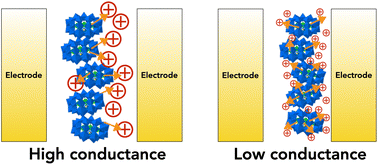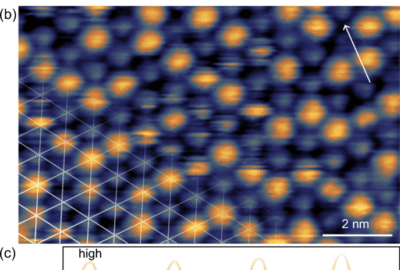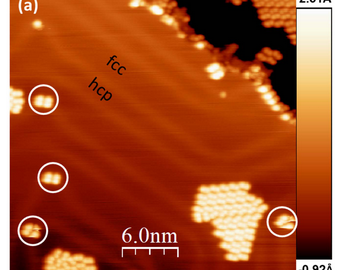publications, Réseau
Experimental observation of the role of countercations in modulating the electrical conductance of Preyssler-type polyoxometalate nanodevices
Polyoxometalates are nanoscale molecular oxides with promising properties that are currently explored for molecule-based memory devices. In this work, we synthesize a series of Preyssler polyoxometalates (POMs), [Na⊂P5W30O110]14−, stabilized with four different counterions, H+, K+, NH4+, and tetrabutylammonium (TBA+). We study the electron transport properties at the nanoscale (conductive atomic force microscopy, C-AFM) of molecular junctions formed by self-assembled monolayers (SAMs) of POMs electrostatically deposited on the ultraflat gold surface prefunctionalized with a positively charged SAM of amine-terminated alkylthiol chains. We report that the electron transport properties of P5W30-based molecular junctions depend on the nature of the counterions; the low-bias current (in the voltage range [−0.6 V; 0.6 V]) gradually increases by a factor of ∼100 by changing the counterion in the order: K+, NH4+, H+ and TBA+. From a statistical study (hundreds of current–voltage traces) using a simple analytical model for charge transport in nanoscale devices, we show that the energy position of the lowest unoccupied molecular orbital (LUMO) of P5W30 with respect to the Fermi energy of the electrodes increases from ∼0.4 eV to ∼0.7 eV and that the electrode coupling energy also increases from ∼0.05 to 1 meV in the same order from K+, NH4+, H+ to TBA+. We discuss several hypotheses on the possible origin of these features, such as a counterion-dependent dipole at the POM/electrode interface and counterion-modulated molecule/electrode hybridization, with, in both cases, the largest effect in the case of TBA+ counterions.
Cécile Huez, Séverine Renaudineau, Florence Volatron, Anna Proust, Dominique Vuillaume Nanoscale, 15, 10634-10641 (2023) doi
Comments are closed






